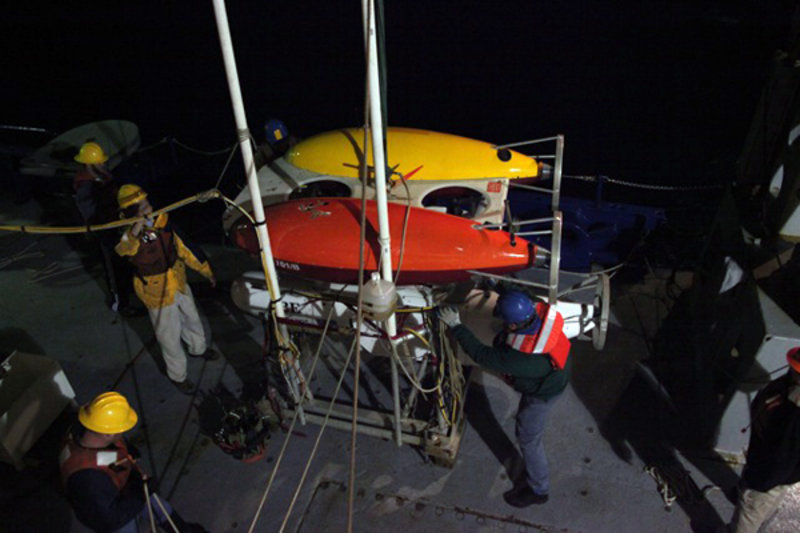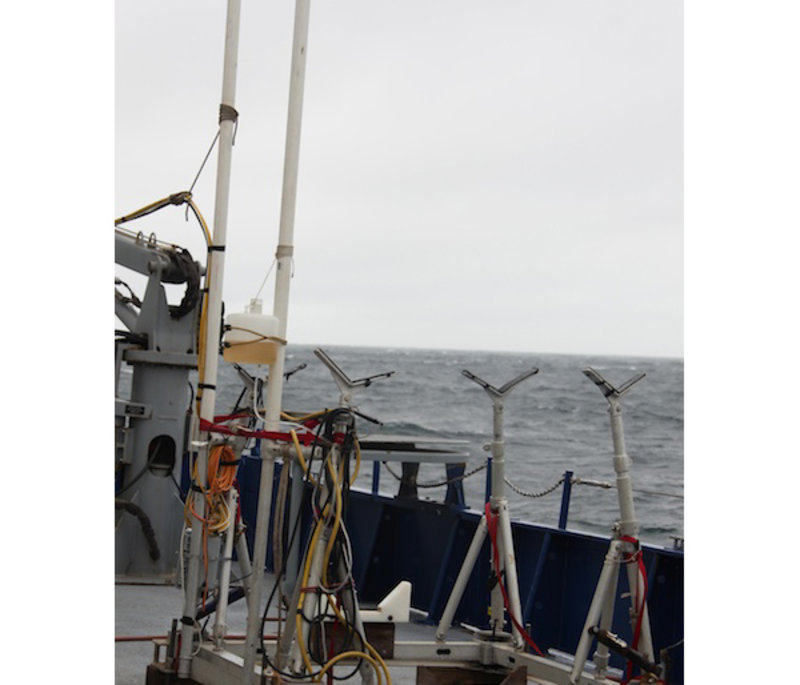
By Jordan Stanway for the ABE Team, Massachusetts Institute of Technology/Woods Hole Oceanographic Institution
March 6, 2010
In oceanography, if your number of recoveries is equal to your number of deployments, you are having a good day.
The ABE team had a bad day yesterday. After ABE (the autonomous benthic explorer) descended to 3 kilometers (1.8 miles) on his 222nd dive, he dropped his descent weight and checked his buoyancy. That was when we lost acoustic tracking.
The research vessel (R/V) Melville loitered over the launch site for several hours while we checked every bit of our tracking system. We boosted the gain, we checked the wiring, and we pinged the transponder net from the ship. Everything was working, but we couldn't hear ABE.
ABE has several completely independent and redundant safety systems for a situation like this. We've used all of them before, and they have all worked. But, we've never lost contact so completely.
ABE is equipped with two acoustic transponders. These are sealed with their own batteries in separate glass balls and listen on different frequencies. We can send an acoustic abort signal to either of them, and ABE will drop his weights and come home. At least, that's how it has happened in the past. This time we sent abort commands to both transponders several times, but we heard no response, and ABE did not surface.

ABE gets ready for his final dive. Line tenders (clockwise from right): Al Duester, Tim Shank, Jim Dorrance, Sean Sylva, and Andy Billings. Image courtesy of INSPIRE: Chile Margin 2010. Download image (jpg, 98 KB).
Someone suggested that ABE might have gone under an overhang or into a hole. He might not be able to hear us where he was. If he were stuck, but still trying to complete his mission, a timer would run out and his programming would tell him to back out. When that happened, he would be able to hear us again, and we would be able to hear him. This has actually happened several times before, and ABE got out of the mess. But there was always some acoustic contact. The Melville stayed in the area longer than that timer, and still ABE didn't show.
We eventually had to move to another site to do a conductivity, temperature, depth (CTD) cast, but we stayed nearby. We could still hear the transponder net in case ABE started using it again.
When all else fails, ABE has another timer with its own batteries that will release the weights about an hour after he should have finished his mission. After that, it normally takes 2 to 3 hours for ABE to surface. During that time, he drifts with the currents. We had a pretty good idea of what these were from Dive 221 the night before. We expected ABE might drift as much as 1,400 meters (4,593 feet) northeast from the point where he left bottom.
ABE has a powerful VHF radio beacon. Once he is on the surface, the ship can use a directional antenna to home in and find him. We listened to our own radio in the lab, and we listened on the bridge, but all we heard was static. ABE was lost.
We check all of these emergency systems before every dive. Each system was working when we put ABE in the water. The descent was uneventful, and the acoustic tracking was working well. ABE was pinging the LBL net, the net was answering, and we could hear it all . . . right up to the point where we couldn't hear anything.
Right now we believe the best explanation is a catastrophic failure. All of ABE's independent emergency systems failed at the same time, which is nearly impossible unless something very bad happened to the entire system at once.
One of the glass balls imploding would be something very bad. A single 17-inch sphere releases almost a megajoule of energy when it implodes at 3,000 m (9,843 ft): ABE had six of those, plus one 12-inch sphere and three 10-inch spheres. If any one of them went, it would have likely caused sympathetic implosions in all the others. The total energy released would have been more than three sticks of dynamite.

ABE's empty cradle on the starboard deck of the Melville. Image courtesy of INSPIRE: Chile Margin 2010. Download image (jpg, 66 KB).
The only problem with this theory is that we didn't hear anything, even on the acoustic tracking system. If a something implodes and releases that much energy, people hear and feel it through the hull of the ship. While we think that this is the most likely explanation, it is hard for any of us to believe we somehow missed hearing it.
ABE played a pioneering role in the development of autonomous underwater vehicles, and in their use for ocean exploration. ABE was the first autonomous robot to make detailed maps of the mid-ocean ridge, and the first to locate new hydrothermal vent sites on the seafloor. ABE was one of the few autonomous underwater vehicles (AUVs) operating in the field with the capability to hover or reverse direction. He operated more like a helicopter than a torpedo, and this allowed him to follow the bottom closely, providing valuable data for deep submergence science.
Epitaph:
Under the wide and restless sea, Lies my grave, now let me be; Glad did I work and now I rest, Now by deadlines no longer stressed. And I lay me down with a will.
This be the verse you grave for me; "Here lies ABE where it longed to be; Home is the sailor, home to the sea, Here it rests, now let it be."— Al Bradley (after Robert Louis Stevenson)
On his 221st dive, ABE collected compelling evidence of hydrothermal activity in the area we were surveying. We can only guess at what he found on his last dive.
We take a risk every time we put an AUV in the ocean, and we always hope that it will come back. In the end, we've lost a member of our team, but I like to think that ABE is happy when he's down deep.